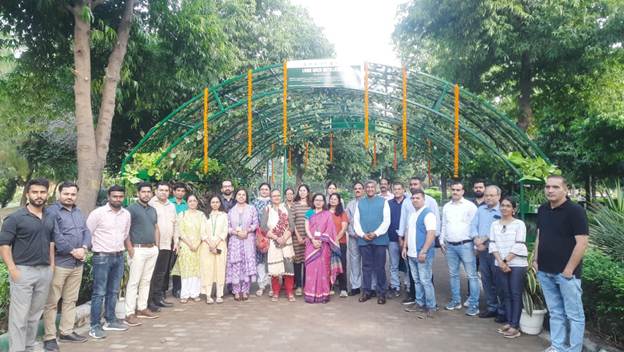‘Breathable Art’: Blending Creativity and Sustainability for Cleaner Air in Urban India

- 12 Oct 2025
In News:
The Ministry of Environment, Forest and Climate Change (MoEFCC) recently inaugurated “Breathable Art” — an innovative living installation at Swarn Jayanti Park, Rohini, Delhi. Conceived under the ‘Breath of Change – Clean Air, Blue Skies’ campaign, the initiative aims to combine artistic expression with ecological functionality to promote awareness on air quality, sustainability, and urban environmental stewardship.
About the Initiative
- Breathable Art is a pioneering “living structure” created from air-purifying plants and eco-friendly materials.
- Sponsored by MoEFCC and supported by the Commission for Air Quality Management (CAQM) and Delhi Development Authority (DDA), it forms part of the Environmental Information, Awareness, Capacity Building and Livelihood Programme (EIACP) under the Environment Education, Awareness, Research and Skill Development (EEARSD) scheme.
- The installation integrates art, science, and community engagement — transforming a public space into an interactive platform for environmental education.
- Visitors can scan QR codes placed around the installation to learn about the plants’ role in air purification and sustainable living practices. This interactive element aims to make environmental learning participatory and accessible.
Features and Ecological Role
The structure uses a mix of air-purifying plant species — such as Areca Palm, Bamboo Palm, Money Plant, Snake Plant, Spider Plant, Parijat, Peace Lily, Arrowhead, Weeping Fig, and Zigzag Plant. These species are recognized for their capacity to absorb harmful pollutants like formaldehyde and benzene, regulate humidity, and enhance oxygen concentration — particularly valuable during Delhi’s winter months when air quality deteriorates sharply.
By embedding these plants into an aesthetically designed structure, Breathable Art offers a passive yet effective solution to urban air pollution. It also enhances local biodiversity and contributes to microclimate regulation within its surroundings.
Community and Educational Dimensions
Beyond its environmental function, Breathable Art serves as:
- An Educational Hub: Hosting students, eco-clubs, and community members for awareness sessions on clean air and sustainable living.
- A Community Catalyst: Encouraging participation of Resident Welfare Associations (RWAs), schools, and volunteers in maintaining and replicating such models across the city.
- A Strategic Urban Intervention: Targeting pollution hotspots to promote green urban aesthetics and inspire behavioral change.
This aligns with India’s broader approach of nature-based solutions for urban environmental management — emphasizing community participation, low-cost interventions, and local ecological resilience.
Significance and Way Forward
- Delhi, one of the world’s most polluted capitals, continues to face critical air quality challenges. Initiatives like Breathable Art highlight how creative, sustainable, and participatory approaches can complement policy-driven measures such as the National Clean Air Programme (NCAP).
- By merging environmental science with public art, the project redefines sustainability as a lived, experiential practice rather than a distant policy goal. It underscores the principle that environmental consciousness begins with individual action and community involvement.
- As urban India grapples with escalating pollution, Breathable Art serves as a replicable model for integrating ecological awareness into everyday spaces — inspiring cleaner, greener, and more mindful cities.
Conclusion:
Breathable Art is not merely an installation but a vision — where art, environment, and community converge to remind citizens that sustainability begins with a single breath. It symbolizes India’s evolving approach to environmental governance — creative, participatory, and rooted in harmony with nature.
